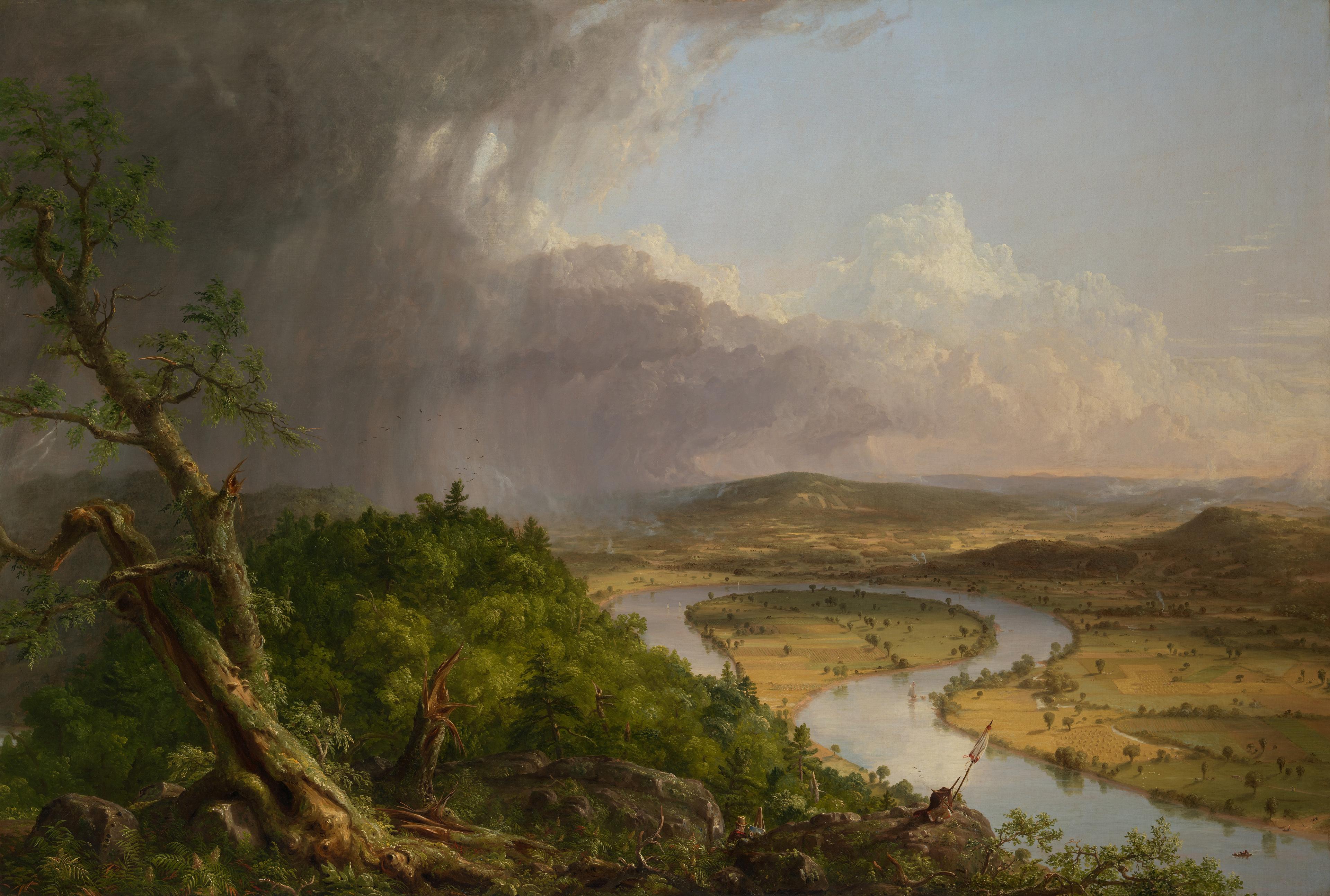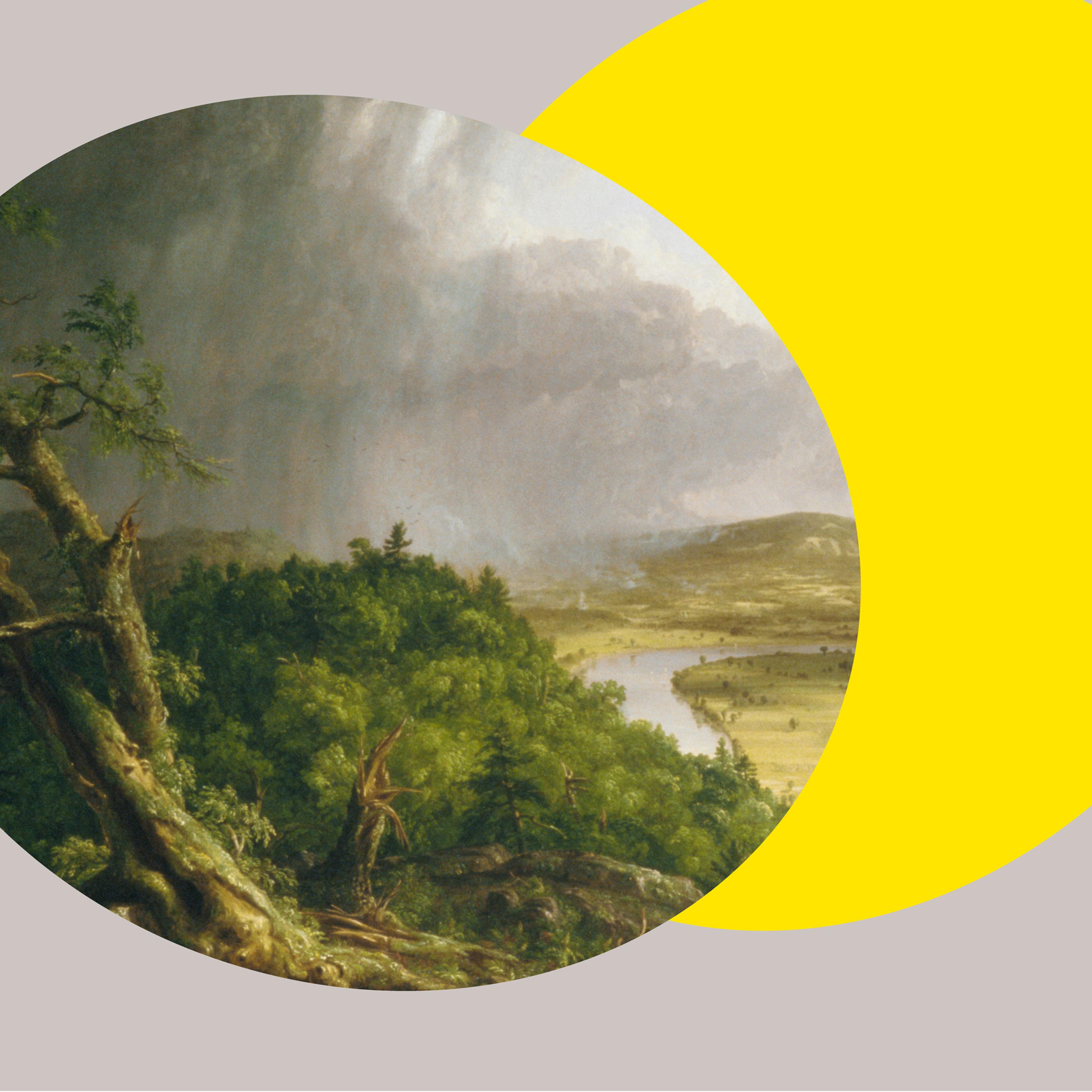Met curator Elizabeth Kornhauser and art historian Alan C. Braddock discuss The Oxbow (1836) by Thomas Cole.
Reexamining the Wilderness Aesthetic
The Oxbow
Listen to the conversation, learn more about the artwork, and read the transcript below.

Thomas Cole (American, 1801–1848). View from Mount Holyoke, Northampton, Massachusetts, after a Thunderstorm—The Oxbow, 1836. Oil on canvas, 51 1/2 x 76 in. (130.8 x 193 cm). The Metropolitan Museum of Art, New York, Gift of Mrs. Russell Sage, 1908 (08.228)
Considered the first proto-environmental artist in the United States, Cole challenged American citizens to question the rapid destruction of wilderness lands in The Oxbow. Cole’s view from the top of Mount Holyoke looking southwest to the Oxbow is regarded as one of his greatest accomplishments. The painting features a momentous self-portrait of the artist, who directly confronts the viewer, signaling the link between art and idea. Faced with the rapid destruction of pure nature, symbolized by the areas of clear-cut forest on the distant mountain, the artist presents a manifesto to the American public urging the preservation of the sublime aspects of the American landscape.
Transcript
ELIZABETH KORNHAUSER: I am Elizabeth Kornhauser, Alice Pratt Brown Curator of American Paintings and Sculpture in the American Wing at The Metropolitan Museum of Art. I have a special interest in nineteenth-century landscape art and in Thomas Cole, in particular.
ALAN C. BRADDOCK: I’m Alan Braddock. I’m the Ralph H. Wark Associate Professor of Art History and American Studies at the College of William and Mary, where I teach courses on North American art and its relation to ecology and environmental history from the early colonial period to the present.
—
KORNHAUSER: Thomas Cole’s The Oxbow, painted in 1836, was a view from the top of Mount Holyoke, looking southwest to the Oxbow, which is a section of the Connecticut River just south of Northampton, Massachusetts. And it’s regarded as one of the most iconic landscapes painted by an American artist.
In this work Cole made many breakthroughs. He introduced the panoramic view of the landscape, which would become a signature for the later Hudson River School painters. He also introduced a shocking bifurcated scene of wilderness on one side and settled land on the other.
The left side is elevated, the wilderness side, and it’s very lushly painted. And then you look far below, down into the valley, and you see very aggressive cultivation of the landscape. On the distant mountain, you see direct signs of clear-cutting deforestation going on. And then of particular interest is that he introduces himself in a very distinctive self-portrait, where he gazes directly out at the viewer.
In its own time, this painting, The Oxbow, was of great importance, but I think that it hasn’t been fully understood until the new discipline of ecocriticism and a deep dive into Thomas Cole’s biography was brought to bear.
BRADDOCK: I couldn’t agree more. You mentioned ecocriticism as a new way of looking. It’s really a kind of environmental lens for understanding the history of art. Thinking about art in relation to ecology is a fundamentally interdisciplinary activity and it produces new kinds of knowledge. And Cole is a really important example of interdisciplinary thinking.
KORNHAUSER: I think Cole was uniquely set up through his background as an Englishman growing up in Bolton le Moors on the northwestern coast of England in the very heart and center of the explosion of the Industrial Revolution in his hometown. Cole was aware that the farmland had quickly disappeared in that part of England, and it was this warning that he embeds in The Oxbow.
BRADDOCK: It’s worth commenting that the perception of America as an uninhabited wilderness is, in its own way, a historical fiction because Indigenous people had inhabited North America and South America.
I also think it’s crucial to understand that this painting was made in the 1830s during the administration of President Andrew Jackson, who was, in every way, trying to unleash the forces of development and business across the United States. It was President Jackson who passed the so-called Indian Removal Act of 1830.
Most people in America were very much committed to the Jacksonian idea of development. And so Cole is kind of an outsider to that dominant way of thinking. And I think that it is possible to see him as a proto-environmentalist—he was concerned about the direction of the country and what was happening to the land because of industry and development.
What’s missing from Cole’s environmentalism is precisely the idea of justice. He was not an activist for Native American sovereignty or racial justice. He was concerned with what was happening to forests and how that would ruin what he perceived to be the very special beauty of North America.
KORNHAUSER: You’re right in pointing out that Cole was very much of his own era and neglects to really acknowledge Native Americans. To take the point even further, the Romantic mind, including Cole’s, really saw the appreciation of wilderness as almost exclusive to White, educated, “civilized,” in quotes, people.
He wrote while he was painting The Oxbow, and I quote, “The ravages of the axe are daily increasing. The most noble scenes are made desolate and oftentimes with a wantonness and barbarism, scarcely credible in a civilized nation.”
That thought process would carry across the nineteenth century into the National Parks Movement.
BRADDOCK: There’s no question that Romanticism helped institutionalize the wilderness aesthetic. And as many historians of ecology and environmental philosophers now recognize, that aesthetic has done some damage to our understanding of history by erasing knowledge about the historical presence of Indigenous people. And it leads us to kind of neglect places like cities because we feel that we’re protecting nature by maintaining the parks.
Now, I and others are not advocating tearing down and selling off the parks. But what we are advocating is a more inclusive and broad notion of environmental protection that takes into consideration cities and towns as having environmental value precisely because it’s where people live.
And so we are kind of calling into question the Romantic wilderness aesthetic these days, but I think we can still admire and appreciate Cole for helping to start a conversation about these issues. And while the wilderness aesthetic has some problems, in his day it was important to protect certain places which otherwise would have just been completely torn to shreds by that juggernaut of Jacksonian capitalism.
KORNHAUSER: I mean, that’s such a good point, and we have been so irresponsible in that regard. Even the site of Mount Holyoke and that oxbow shape in the river is no longer there. You know, over the course of the twentieth century with changing settlement patterns, the introduction of industry along the river, frequent flooding and much more flooding now due to climate change. And finally, you know, the Oxbow itself became closed and it was bisected by a highway. And that again makes it a very important and powerful work.
BRADDOCK: I think the staying power of this painting provides vivid proof that art is a key player in helping us understand our history, our ecology, our environmental relations. And I’d like to think that The Oxbow lives on and challenges us to imagine a new way to think about nature that is more inclusive, more democratic, and more just.
###
